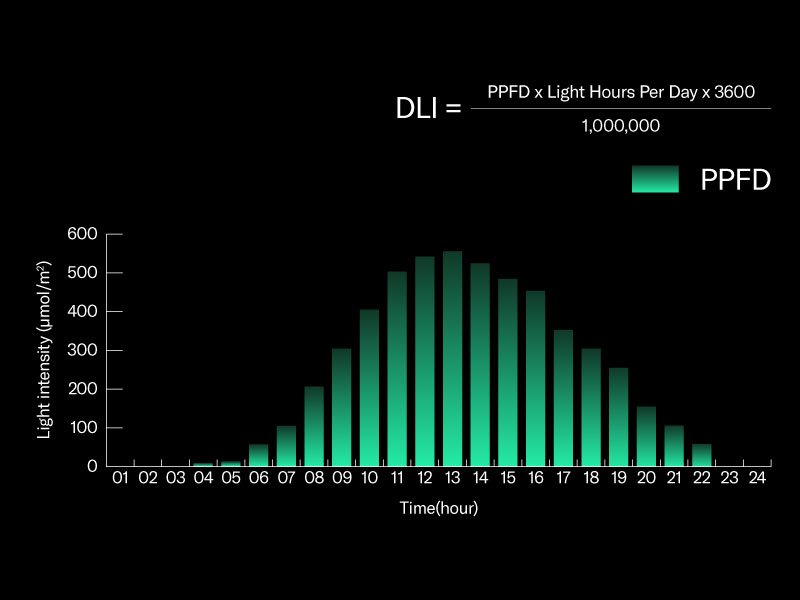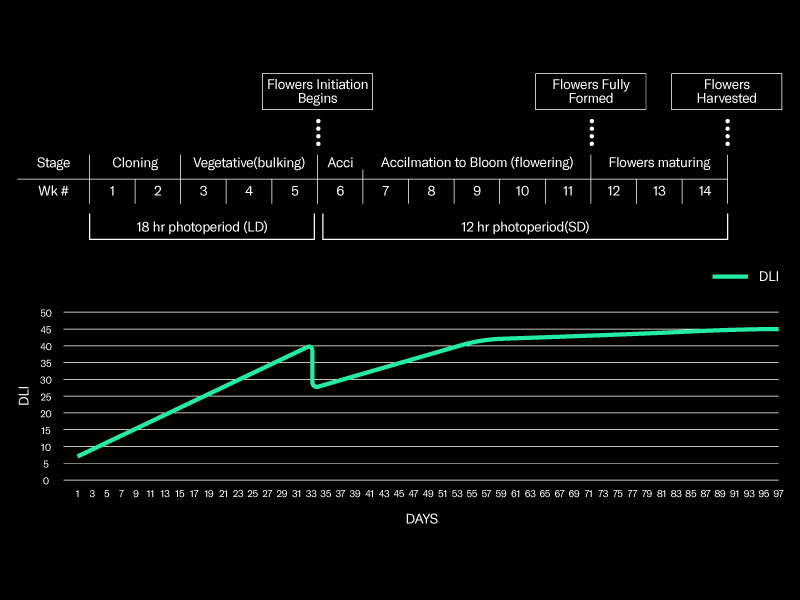1. Introduction to DLI
In cannabis cultivation, maximizing plant growth and yields requires more than just watering and nutrients. One of the most crucial yet often overlooked elements is light management—especially the concept of Daily Light Integral, or DLI. Understanding DLI and how it applies to cannabis cultivation can significantly improve plant health, accelerate growth, and boost yields.
2. What is DLI (Daily Light Integral)?
2.1 Definition of DLI
DLI, or Daily Light Integral, measures the total amount of photosynthetically active light (PAR) plants receive over a 24-hour period. Expressed in moles per square meter per day (mol/m²/day), DLI is more comprehensive than other metrics, such as light intensity or PPFD (Photosynthetic Photon Flux Density), because it accumulates light exposure over time.
2.2 How DLI Differs from Other Light Metrics (PPFD, PPF)
Unlike PPFD, which measures the light intensity at a specific moment, DLI offers a cumulative view, giving growers a full picture of the plant’s daily light intake. This distinction is crucial, as high-intensity light for a few hours isn’t the same as moderate light over an entire day when it comes to plant development.
3. Importance of DLI in Cannabis Growth
3.1 Impact on Plant Health and Yields
DLI directly affects photosynthesis rates in cannabis plants, impacting growth, resin production, and overall yield potential. High DLI levels are typically associated with faster growth and more robust plants.
3.2 DLI and the Growth Stages of Cannabis
Each growth stage has unique DLI needs. By adjusting DLI for each phase—seedling, vegetative, and flowering—growers can ensure plants receive the right light levels to maximize development at every stage.
4. How DLI Affects Photosynthesis
Photosynthesis is the process by which cannabis plants convert light into chemical energy. DLI, therefore, plays a critical role in driving photosynthesis rates, which in turn influences the plant’s metabolic functions, growth, and health. When DLI is optimized, plants use light energy more effectively, leading to higher cannabinoid and terpene production.
5. Measuring DLI in a Grow Room
5.1 Tools and Equipment Needed
A PAR meter or a light sensor capable of measuring PPFD is essential for calculating DLI. Many commercial devices are designed specifically for grow rooms.
5.2 Steps to Calculate DLI
- Measure the PPFD at canopy level.
- Multiply by the number of hours lights are on per day.
- Use this formula: (PPFD × Hours per day × 3,600) ÷ 1,000,000 = DLI (in mol/m²/day)

6. Optimal DLI Levels for Cannabis by Growth Stage
6.1 Seedling Phase
Seedlings are delicate and can suffer from too much light, making a DLI of 6-15 ideal.
6.2 Vegetative Phase
As the plant grows, its light requirements increase. A DLI range of 20-40 encourages rapid vegetative growth without causing light stress.
6.3 Flowering Phase
In the flowering phase, cannabis plants often benefit from a DLI between 25 and 45, which helps maximize bud density and resin production.

7. DLI Requirements for Different Cannabis Strains
7.1 Differences in Light Requirements by Strain
Cannabis strains differ in their light needs. Indica strains generally thrive on lower DLI levels, while Sativa and hybrid strains often benefit from higher levels. Adjusting DLI for specific strains ensures optimal growth and avoids light stress.
7.2 Tips for Strain-Specific DLI Adjustments
Experiment with different DLI levels and monitor plant response. Increasing light incrementally helps you find the sweet spot for each strain.
8. How to Adjust Lighting to Reach Optimal DLI
8.1 Light Intensity and Duration Adjustments
Increase either the intensity (PPFD) or the duration of light exposure to reach the target DLI. For example, extending light hours by 1-2 hours daily can help meet DLI requirements without needing additional lights.
8.2 Tips for Using Supplemental Lighting
For indoor setups, supplemental LED lights like under canopy lights can be used to boost DLI without increasing heat output. Outdoor growers can use movable lights for cloudy days or shaded areas.
9. Managing DLI in Indoor vs. Outdoor Cultivation
9.1 Challenges of Indoor DLI Control
Indoor growers have greater control but must balance light intensity with heat management.
9.2 Seasonal Adjustments for Outdoor Growing
Outdoor growers must adapt to changing sunlight hours and conditions throughout the year. Using supplemental lights during winter can help maintain consistent DLI.
10. Signs of DLI Imbalance
10.1 Symptoms of Too Low DLI
Plants with low DLI often appear stretched, with sparse foliage and lower yields.
10.2 Symptoms of Too High DLI
Overexposure to light can cause light bleaching, yellowing leaves, and stunted growth.
11. Common Mistakes When Adjusting DLI
- Over-lighting during the seedling phase.
- Ignoring strain-specific light needs.
- Failing to adjust DLI as plants transition between growth phases.
12. Tips for Increasing DLI without Causing Light Stress
- Gradually increase light intensity to help plants acclimate.
- Use dimmable lights like Flexstar LED lights for better control.
- Ensure proper ventilation to dissipate heat and reduce light stress.
13. Tools and Technology for DLI Management
13.1 Light Meters and Calculators
Light meters measure real-time PPFD, making it easier to calculate DLI accurately. Some apps also provide DLI estimates based on regional sunlight data for outdoor growers.
13.2 Automated Systems and Apps
Automated lighting systems allow you to set DLI targets, and many include timers and dimmers to make adjustments easier.
14. Future Trends in DLI and Cannabis Cultivation
With advancements in grow light technology, DLI management will continue to evolve. Future innovations may include adaptive lighting systems that automatically adjust to achieve optimal DLI levels for specific strains and stages.
Conclusion: Using DLI for Maximum Yields in Cannabis
Understanding and managing DLI is one of the most effective ways to optimize cannabis growth and maximize yields. By measuring, adjusting, and monitoring DLI levels, growers can ensure their plants receive the ideal light exposure to thrive in every stage.
